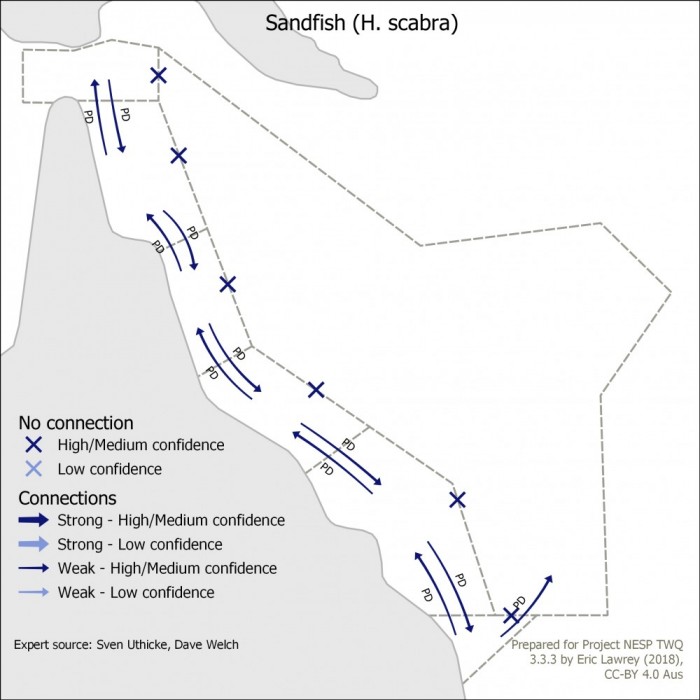Sandfish connectivity
Introduction to sandfish and why they are important
Holothuroids (all sea cucumbers) in general play important ecological roles (Purcell et al. 2016). One role is remineralising large quantities of organic nutrients through their feeding and burying activities (Uthicke, 2001a), which increases the benthic productivity of coral reefs (Uthicke & Klumpp 1998; Uthicke 2001b). Further, the role of sea cucumbers in the dissolution of CaCO3 sediment provides an important source of alkalinity and may play a role in buffering ocean acidification at least at local scales on coral reefs. (Schneider et al. 2011; Purcell et al. 2016).
In Australia sandfish, Holothuria scabra, are found across northern Australia and extend down the east coast to the Qld/NSW border (Welch, 2014). They are usually associated with sandy, muddy substrates in nearshore coastal environments and so are not found in the Coral Sea. They have been demonstrated to be important bioturbators (Purcell, 2004). Sandfish are capable of spawning year round in warmer equatorial waters (Morgan, 2000), and preferred habitat types for settlement of the larvae appear to be on seagrass leaves (Mercier et al. 2000) with cues including the presence of particular food types such as diatoms and certain bacteria (Battaglene, 1999).
Sandfish are one the highest value sea cucumber species and are one of several main target species in the east coast fishery. The fishery operates under a system of effort restrictions using rotational zones that limit access (number of days) to each reef or group of reefs. This is a voluntary industry initiative implemented via a memorandum of understanding. There is also a quota limit for all species. In the Torres Strait, due to overfishing on the Warrior reefs, the sandfish fishery has been closed since 1999 and stocks have not yet recovered. Also the fishery in the Sandy Strait region (Hervey Bay) has been closed since 2001 due to declining stocks (Roelofs, 2004).
In cultured situations for sandfish temperatures are kept between 26 °C and 29 °C during larval development. Larvae feed on different species of micro-algae and successful metamorphosis has been shown to be dependent on the algal species consumed. One of the better algal species, Chaetoceros muelleri, is very tolerant of high temperatures (Battaglene, 1999). Larvae develop through the feeding stage auricularia, the non-feeding doliolaria, and the pentactula stage that develops tentacles and settles (Fig 3.; Ramofafia et al, 2003). Generally, however, very little is known of the larval movement and settlement processes in the wild (Conand, 2006).
Key concepts that relate to connectivity
Typically, successful recruitment of low mobility marine organisms such as sea cucumbers require adequate adult densities to ensure successful fertilisation of released eggs. Also, they generally have very low replenishment rates making them susceptible to overfishing and slow at recovering from perturbations. Further, dispersal of recruits is spatially limited. For sandfish this has resulted in there being multiple discrete stocks throughout Queensland (Uthicke and Benzie, 2001). This would suggest that separate stocks exist in each of the Torres Strait, the Great Barrier Reef Marine Park and Sandy Strait regions.
References
Battaglene, S.C. (1999) Culture of tropical sea cucumbers for stock restoration and enhancement. Naga, The ICLARM Quarterly, Vol. 22, No. 4, October-December, 1999, ICLARM Contribution No. 1501, Solomon Islands.
Conand, C. (2006) Sea cucumber biology, taxonomy, distribution and conservation status. In: Bruckner, A.W. (editor). 2006. Proceedings of the CITES workshop on the conservation of sea cucumbers in the families Holothuriidae and Stichopodidae. NOAA Technical Memorandum NMFSOPR 34, Silver Spring, MD 244 pp.
Mercier, A., Battaglene, S.C., and Hamel, J.F. (2000). Settlement preferences and early migration of the tropical sea cucumber, Holothuria scabra. Journal of Experimental Marine Biology and Ecology, 249(1): 89-110.
Morgan, A.D. (2000) Aspects of the reproductive cycle of the sea cucumber Holothuria scabra (Echinodermata: Holothuroidea). Bulletin of Marine Science, 66(1): 47-57.
Purcell, S. (2004) Rapid growth and bioturbation activity of the sea cucumber Holothuria scabra in earthen ponds. Proceedings of Australasian Aquaculture 1, 244 only.
Purcell, S.W., Conand, C., Uthicke, S. and Byrne, M. (2016) Ecological roles of exploited sea cucumbers. Oceanography and Marine Biology: An Annual Review, 2016, 54, 367-386
Ramofafia, C., Byrne, M. And Battaglene, S.C. (2003) Development of three commercial sea cucumbers, Holothuria scabra, H. fuscogilva and Actinopyga mauritiana: larval structure and growth. Marine and Freshwater Research, 54(5): 657-667.
Roelofs, A. (2004) Ecological assessment of Queensland's East Coast Bêche-de-mer Fishery. A report to the Australian Government Department of Environment and Heritage on the ecologically sustainable management of a highly selective dive fishery, Department of Primary Industries and Fisheries, Brisbane, Australia.
Schneider, K., Silverman, J., Woolsey, E., Eriksson, H., Byrne, M. and Caldeira, K.. (2011) Potential influence of sea cucumbers on coral reef CaCO3 budget: A case study at One Tree Reef. Journal of Geophysical Research 116: G04032, doi:10.1029/2011JG001755.
Uthicke, S. (2001a) Nutrient regeneration by abundant coral reef holothurians. Journal of Experimental Marine Biology and Ecology, 265: 153–170.
Uthicke, S. (2001b) Interactions between sediment-feeders and microalgae on coral reefs: grazing losses versus production enhancement. Marine Ecology Progress Series, 210: 125–138.
Uthicke, S. and J. A. H. Benzie. (2001) Restricted gene flow between Holothuria scabra (Echinodermata: Holothuroidea) populations along the north-east coast of Australia and the Solomon Islands. Marine Ecology Progress Series, 216:109-117.
Uthicke, S. and D.W. Klumpp. (1998) Microbenthos community production in sediments of a near shore coral reef: seasonal variation and response to ammonium recycled by holothurians. Marine Ecology Progress Series, 169: 1–11.
Welch, D. (2014) Sea cucumbers (beche de mer, trepang). In: Welch, D.J., J. Robins, and T. Saunders (editors) (2014) Implications of climate change impacts on fisheries resources of northern Australia. Part 2: Species profiles. Final report to Department of Agriculture, Fisheries and Forestry, and the Fisheries Research and Development Corporation, Canberra, Australia. https://docs.wixstatic.com/ugd/9d521f_3bdc7908b0b84f25a8a17caf74903dac.pdf







